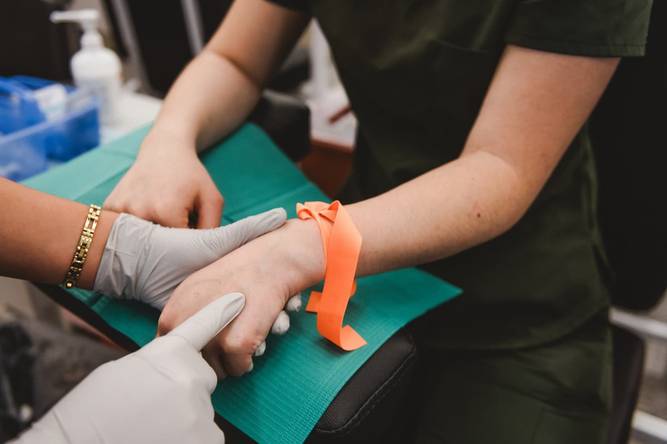In recent years, the healthcare landscape has undergone a significant transformation, with mobile phlebotomy services emerging as a game-changer. ? These services not only enhance patient convenience but also improve access to essential healthcare. As the demand for home draw services continues to rise, understanding the training and skills required for mobile phlebotomists becomes crucial. This blog will explore the impact of mobile phlebotomy training, the statistics behind its growth, and how it is reshaping the field of healthcare.

The Rise of Mobile Phlebotomy Services
Mobile phlebotomy services have gained traction due to their ability to provide patients with a more comfortable and convenient experience. According to a recent survey, over 70% of patients prefer receiving blood draws at home rather than visiting a clinic. This preference is driven by various factors, including:
- Convenience: Patients can schedule appointments at their convenience, eliminating the need for travel.
- Comfort: Many individuals feel more at ease in their own environment, reducing anxiety associated with medical procedures.
- Accessibility: Home draw services are particularly beneficial for elderly patients or those with mobility issues.
Statistics on Mobile Phlebotomy Growth
The mobile phlebotomy market is projected to grow significantly in the coming years. Here are some key statistics that highlight this trend:
| Year | Market Size (in Billion USD) | Growth Rate (%) |
|---|---|---|
| 2020 | 1.5 | - |
| 2021 | 2.0 | 33.3 |
| 2022 | 2.7 | 35.0 |
| 2023 | 3.5 | 29.6 |
| 2024 | 4.5 | 28.6 |
As shown in the table above, the mobile phlebotomy market is expected to reach $4.5 billion by 2024, reflecting a robust growth trajectory. ? This growth is fueled by the increasing acceptance of telehealth services and the rising demand for at-home healthcare solutions.
Training for Mobile Phlebotomists
To meet the growing demand for mobile phlebotomy services, proper training is essential. Mobile phlebotomists must possess a unique set of skills that differ from traditional phlebotomists. Here are some key components of mobile phlebotomy training:
- Technical Skills: Proficiency in blood collection techniques, including venipuncture and capillary draws.
- Patient Interaction: Strong communication skills to ensure patients feel comfortable and informed throughout the process.
- Safety Protocols: Knowledge of infection control and safety measures to protect both the patient and the phlebotomist.
- Time Management: Ability to efficiently manage appointments and travel time to maximize productivity.
Training Programs and Certifications
Several organizations offer specialized training programs for aspiring mobile phlebotomists. Here’s a comparison of some popular training options:
| Training Program | Duration | Cost (Approx.) | Certification Offered |
|---|---|---|---|
| National Phlebotomy Association (NPA) | 4 weeks | $800 | NPA Certification |
| American Society for Clinical Pathology (ASCP) | 6 weeks | $1,200 | ASCP Certification |
| Phlebotomy Training Specialists | 3 weeks | $600 | Certificate of Completion |
These programs equip students with the necessary skills and knowledge to excel in the field. Additionally, many mobile phlebotomy services prefer hiring certified professionals, making certification a valuable asset. ?
The Future of Mobile Phlebotomy
As technology continues to advance, the future of mobile phlebotomy looks promising. Innovations such as telehealth integration and mobile health applications are expected to enhance service delivery. For instance, platforms like LabCorp and Quest Diagnostics are already incorporating mobile phlebotomy services into their offerings, making it easier for patients to access care.
Benefits of Mobile Phlebotomy
The benefits of mobile phlebotomy extend beyond patient convenience. Here are some advantages for healthcare providers:
- Increased Patient Retention: Offering home draw services can lead to higher patient satisfaction and loyalty.
- Cost-Effectiveness: Reducing the need for physical office space and resources can lower operational costs.
- Expanded Reach: Providers can serve a broader patient base, including those in remote areas.
| Benefit | Description |
|---|---|
| Increased Patient Retention | Higher satisfaction leads to repeat visits. |
| Cost-Effectiveness | Lower operational costs for providers. |
| Expanded Reach | Ability to serve patients in remote locations. |
Conclusion
Mobile phlebotomy training is revolutionizing the way blood draws are conducted, making healthcare more accessible and patient-friendly. With the market projected to grow significantly, the demand for trained mobile phlebotomists will only increase. As healthcare continues to evolve, embracing these changes will be essential for both patients and providers. ?
For those interested in pursuing a career in mobile phlebotomy, now is the perfect time to explore training options and certifications. By doing so, you can be part of a transformative movement that is reshaping the future of healthcare.



